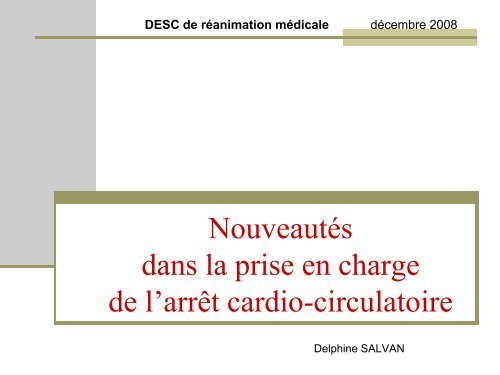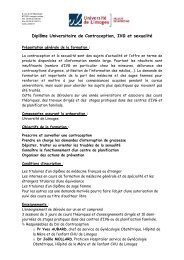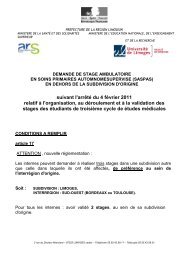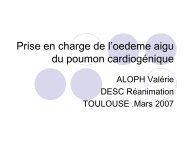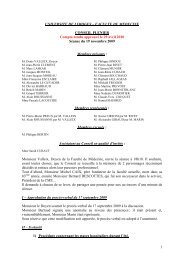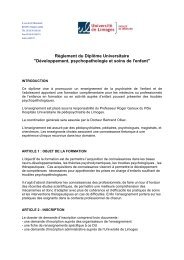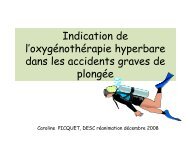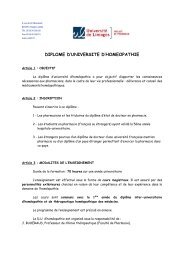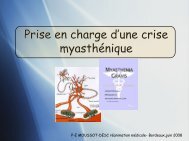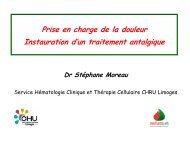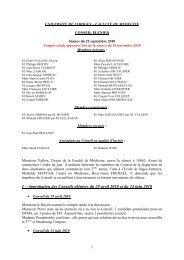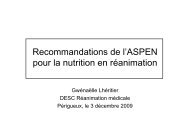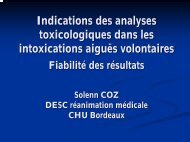Nouveautés dans la prise en charge de l'arrêt cardio-circulatoire
Nouveautés dans la prise en charge de l'arrêt cardio-circulatoire
Nouveautés dans la prise en charge de l'arrêt cardio-circulatoire
You also want an ePaper? Increase the reach of your titles
YUMPU automatically turns print PDFs into web optimized ePapers that Google loves.
DESC <strong>de</strong> réanimation médicale décembre 2008<strong>Nouveautés</strong><strong>dans</strong> <strong>la</strong> <strong>prise</strong> <strong>en</strong> <strong>charge</strong><strong>de</strong> l’arrêt <strong>cardio</strong>-circu<strong>la</strong>toireDelphine SALVAN
Épidémiologie :Un problème <strong>de</strong> santé publique40 000 morts subites/an <strong>en</strong> FranceSurvie immédiate 14% survie à 1mois 2,5%Age moy<strong>en</strong> 67 ans , 2♂/1♀64 %27 %9 %
Alerte et diagnostic La reconnaissance <strong>de</strong> l’ACR :- Pour le public : abs<strong>en</strong>ce <strong>de</strong> signe <strong>de</strong> vieACR <strong>de</strong>vant témoins : 70%RCP par témoins :13%- Pour les secouristes et professionnels <strong>de</strong> santé :abs<strong>en</strong>ce <strong>de</strong> signe <strong>de</strong> circu<strong>la</strong>tion Rapi<strong>de</strong> 10 secon<strong>de</strong>s Décl<strong>en</strong>chem<strong>en</strong>t <strong>de</strong>s secours et début <strong>de</strong> RCP
La RCP <strong>de</strong> baseCompressions thoraciques : prioritaires !Mainti<strong>en</strong> gradi<strong>en</strong>t <strong>de</strong> pressionpour une perfusion coronaireMainti<strong>en</strong> remplissage adéquat du VG,étirem<strong>en</strong>t myocyte (pré<strong>charge</strong>)Débute par 30 MCEAlternance 30/2 insuff<strong>la</strong>tionsTemps insuff<strong>la</strong>tion=1sec
Le massage cardiaque instrum<strong>en</strong>tal• MCE = débit <strong>de</strong> 25% du DC normalCompression abdominale intermitt<strong>en</strong>teCardio-Pump ®AmbuAutopulse ®, système lucas ®• Augm<strong>en</strong>te l’efficacité hémodynamique du massage• Pronostic à court terme : amélioré• Pronostic à long terme : non amélioré
La défibril<strong>la</strong>tionautomatisé externe• Améliore le pronostic <strong>de</strong> ACRBunch, NEJM 2003; 348: 2626-33• Le plus tôt possibleChan NEJM 2008; 358: 9-17• Si <strong>la</strong> victime est restée p<strong>en</strong>dant plus <strong>de</strong> 4-5min sans RCP :2 minutes <strong>de</strong> RCPavant analyse du rythme et défibril<strong>la</strong>tionWik, JAMA 2003; 289: 1389-95• Si CEE faire 2 minutes <strong>de</strong> RCP, puis analyse du rythmecardiaque, recherche prés<strong>en</strong>ce d’un poul.
RCP médicalisée1- V<strong>en</strong>ti<strong>la</strong>tion• O2 le plus rapi<strong>de</strong>m<strong>en</strong>t• IOT dés que possible, pas ou peu d’interruptiondu MCE : 30 secon<strong>de</strong>s maximum• Après vérification IOT, usage respirateurVAC 6-7ml/kg 10c/min FiO2=1
RCP médicalisée2- VasoconstricteursL’adrénaline = vasopresseur standard <strong>dans</strong> l’ACR• 1mg / 2 cycles <strong>de</strong> RCP (4 min)Si pas d’abord vascu<strong>la</strong>ire et/ou intra osseux : 2-3mg/10ml EPPI <strong>en</strong> intratrachéal.• SI FV/TV sans pouls après 2 min <strong>de</strong> RCPavant le 2 ème ou 3 ème CEE <strong>en</strong> abs<strong>en</strong>ce <strong>de</strong> RACS.• Si asystolie réfractaire augm<strong>en</strong>tation <strong>de</strong>s doses à 5mg/injectionpossible.
Intérêt <strong>de</strong> <strong>la</strong> vasopressine <strong>dans</strong> l’ACR- étu<strong>de</strong>s animales-+• ↑ Perfusion coronaireLindner KH Circu<strong>la</strong>tion 1995W<strong>en</strong>zel V Circu<strong>la</strong>tion-• ↑ Consommationmyocardique d’O2• ↑ Débit sanguin cérébral↑ Oxygénation cérébralePr<strong>en</strong>gel AW Stroke 1996↑ Pronostic neurologique• ↑ Trouble du rythmev<strong>en</strong>tricu<strong>la</strong>ireParadis NA Cardiol Clin 2000• ↑ SurvieW<strong>en</strong>zel V J Am Coll Cardiol 2000
A Comparison of Vasopressin and Epinephrine for Outof-Hospital<strong>cardio</strong>pulmonary ResuscitationW<strong>en</strong>zel et co. NEJM january 8, 2004 vol 350
A Comparison of Vasopressin and Epinephrine for Outof-Hospital<strong>cardio</strong>pulmonary ResuscitationW<strong>en</strong>zel et co. NEJM january 8, 2004 vol 350Supériorité <strong>de</strong> <strong>la</strong> vasopressine <strong>dans</strong> l’asystolieIntérêt <strong>de</strong> l’association <strong>dans</strong> l’ACR réfractaire ???
Intérêt <strong>de</strong> <strong>la</strong> vasopressine <strong>dans</strong> l’ACRVasopressin for Cardiac Arrest Koko AungAmerican Medical Association 2005
Vasopressine <strong>dans</strong> l’ACR-Recommandations-• The 2005 International Cons<strong>en</strong>sus on CardiopulmonaryResuscitation and Emerg<strong>en</strong>cy Cardiovascu<strong>la</strong>r CareSci<strong>en</strong>cewith Treatm<strong>en</strong>t Recommandations :« There is insuffici<strong>en</strong>t evid<strong>en</strong>ce to support or refute the use ofvasopressin as an alternative to, or in combination with,ad<strong>en</strong>aline in any cardiac arrest rhythm. »• SFAR 2006 :vasopressine ou vasopressine+ adrénaline= alternative notamm<strong>en</strong>t <strong>en</strong> cas d’asystolieNe pas dépasser <strong>de</strong>ux injections <strong>de</strong> 40UI
• Étu<strong>de</strong> prospective, double aveugle, multic<strong>en</strong>trique, randomisée.• Critère principal <strong>de</strong> jugem<strong>en</strong>t : survie à l’admission à l’hôpital,1mg épinéphrine + 40 UI vasopressine+3min si pas <strong>de</strong> RACS :i<strong>de</strong>m1mg épinéphrine + serum phy+3min si pas <strong>de</strong> RACS :i<strong>de</strong>m+ 3 min si pas <strong>de</strong> RACS épinéphrine• En ITT , α = 0,05 β = 90% , nombre sujets nécessaire : 2416• De mai 2004 à avril 2006 : 2956 pati<strong>en</strong>ts randomisés, 62 exclus, 2956analyse 1442/1452
Pas <strong>de</strong> bénéfice
RCP médicalisée2- les antiarythmiques• AmiodaroneSi FV/TV sans pouls avant le 3 ème ou 4 ème CEE : 300mgSi FV persistante ou récidivante : 150mg+/- suivie <strong>de</strong> 900mg/j <strong>en</strong> ivseBénéfice sur survie précoce (Dorian NEJM déc 9, 2008)• Lidocaine si amiodarone non disponible• Sulfate <strong>de</strong> magnésium- torsa<strong>de</strong> <strong>de</strong> pointe- FV résistantes au choc avec contexte d’hypomagnésémie.
RCP médicalisée3-Autres thérapeutiques• Atropineau cas par cas si activité électrique sans pouls après unebradycardie efficace : bolus unique <strong>de</strong> 3mg.• Alcalinisationnon indiqué <strong>en</strong> routine, uniquem<strong>en</strong>t si :- Hyperkaliémie préexistante- acidose métabolique préexistante- Intoxication drogues à effets stabilisants <strong>de</strong> membranes• La thrombolyse- Si suspicion d’EP,au cas par cas si suspicion thrombose coronaire.Prolongation RCP : 60-90 minutes
Stratégie <strong>de</strong> défibril<strong>la</strong>tion• Si biphasique 150-200J si monophasique 360J.Biphasique ou monophasique pas <strong>de</strong> différ<strong>en</strong>ces Kud<strong>en</strong>chuk Circu<strong>la</strong>tion 2006Augm<strong>en</strong>tation <strong>de</strong> l’énergie progressive 200 300 360 Stiell Circu<strong>la</strong>tion 2007TV/FV : 1 er CEE + RCP 2’RACSTV/FV : +/- Adrénaline puis 2 ème CEE + RCP 2’RACSTV/FV +/- Amiodarone ou Adrénaline puis 3 ème CEE +RCP 2’RACSTV/FV : Amiodarone puis 4 ème CEE+ RCP 2’• Si doute <strong>en</strong>tre une asystolie et FV à petites mailles : continuer <strong>la</strong> RCP,pas <strong>de</strong> CEE
Réanimation post AC ++++1 - Mainti<strong>en</strong> <strong>de</strong> l’homéostasie Respiratoire Hémodynamique : Instabilité 24-48H après ACR- lésions <strong>de</strong> reperfusion,- profil Hémodynamique complexe : sepsis like Manifestations épileptiques à rechercher et traiter2-Limiter les séquelles neurologiquespost-anoxiques
MILD THERAPEUTIC HYPOTHERMIA TO IMPROVE THENEUROLOGIC OUTCOME AFTER CARDIAC ARRESTHolzer et co. NEJM 2002
Protection cérébraleHypothermie32°-34°C 12 à 24 heures(curarisation)+++ FVComplications :- Infections,- Instabilité hémodynamique ,- Coagulopathies,- Tr hydroélectrolytiques, hyperglycémie↓ du métabolisme cérébral↓ lésions <strong>de</strong> reperfusion parinhibition <strong>de</strong> radicaux libres,↓ acidose intracellu<strong>la</strong>ire
Évaluation du pronostic neurologique J3Clinique +++Electrophysiologie+++EEG : Peu utilesauf si tracés péjoratifsArbre décisionnel proposé par C. Fisher
Situations particulières• NOYADESDébuter <strong>la</strong> RCP par 5 insuff<strong>la</strong>tions,• HYPOTHERMIE ACCIDENTELLERCP jusqu’au réchauffem<strong>en</strong>tDavid, CCM 2007• ARRET CARDIAQUE TRAUMATISMEMauvais pronostic- PNO compressif exsuffaltion, thoracotomie- Désamorçage hypovolémique remplissage• Arrêt cardiaque et intoxicationsRCP prolongée, si stabilisant <strong>de</strong> membrane : bicarbonate, p<strong>en</strong>ser auxantidotesSi réfractaire p<strong>en</strong>ser à l’assistance circu<strong>la</strong>toire périphérique
Éthique• Respect <strong>de</strong> <strong>la</strong> volonté du pati<strong>en</strong>tdirectives anticipées, personne <strong>de</strong> confiance• Si pas <strong>de</strong> RACS après 30 minutes <strong>de</strong> RCP etpas <strong>de</strong> facteur <strong>de</strong> protection neurologique• Information à <strong>la</strong> famille
• Predicting survival with good neurological recovery at hospital admission after successfulresuscitation of out-of-hospital cardiac arrest : the OHCA scoreAdrie European Heart Journal 2006Réfer<strong>en</strong>ces• ERC gui<strong>de</strong>lines for Resuscitation 2005• Prise <strong>en</strong> <strong>charge</strong> <strong>de</strong> l’arrêt cardiaque- recommandations formalisées d’expert- sept 2006-SFAR• Vasopressin and Epinephrine vs. Epinephrine Alone in <strong>cardio</strong>pulmonary ResuscitationGuegniaud NEJM 459;1 july 3, 2008• A comparison of Vasopressin and Epinephrine for Out-of-Hospital CardiopulmonaryResuscitation W<strong>en</strong>zel NEJM 350 january 2004• Mild therapeutic hypothermia to improve the neurologic outcome after cardiac arrestHolzer NEJM 2002• Progress in ResuscitationPeberdy JAMA vol 299 No 10, March 12, 2008• Long-Term Outcomes of Out-of-Hospital Cardiac Arrest sfter Successfull Early Defibril<strong>la</strong>tionBunch NEJM 2003• Amiodarone as compared with lidocaine for shock resistant v<strong>en</strong>tricu<strong>la</strong>r fibril<strong>la</strong>tionDorian NEJM Vol.346, No 12, March 21,2002


